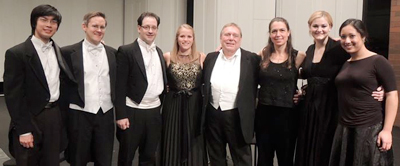by Tom Wachunas
What is it about witnessing a live performance of orchestral music that makes it so uniquely …magical? While the advanced technology of digital recordings these days can certainly produce thoroughly engaging aural experiences, there’s still much to recommend the notion that seeing is believing.
So it is that the eclectic program, conducted by Gerhardt Zimmermann for the November 2 performance by the Canton Symphony Orchestra at Umstattdt Performing Arts Hall, was specifically designed to spotlight various soloists from the ensemble — to let them literally stand and be seen as they soared. And that they did with astonishing technical and interpretive finesse.
Featured in Vivaldi’s Concerto for Two Violins in a minor, No. 8, were CSO first violinist Rachel Sandman and principal second violinist Solomon Liang. From the propulsive episodes of the first movement and through to the ebullient finale, their shimmering, warm tonalities were nothing short of hypnotic. The interweaving of their respective turns leading and accompanying, particularly in the plaintive solemnity of the central movement with its high lyrical melody lines, was seamless. Throughout the work, they played with inspired unity of purpose, making all the more palpable an uncanny sense of completing each other’s lyrical sentences.
That same sensibility was clearly evident among the soloists for the remainder of the program. CSO Concertmaster Justine Lamb-Budge was joined by principal flutist Katherine DeJongh and harpsichordist Parker Ramsey for Bach’s Brandenburg Concerto No. 5. While the soloists certainly performed with all the virtuosic grace and vigor that Bach invested in the work, the overall presentation here was not without its problematic moments. Beyond the too-slow tempo of the third movement, casting a somewhat sterile pall over the ensemble, there was the more significant challenge of hearing the harpsichord, a major component in this work. At issue was the instrument itself. Its sound was often so diaphanous as to be nearly inaudible in the mix with other instruments. Still, during the monumental (65 bars!) harpsichord cadenza in the first movement, the audience was bedazzled enough. We even seemed to have stopped breathing as we leaned forward to savor Ramsey’s riveting dexterity.
The marvelous playing by flutist DeJongh, Meghan Guegold (principal French horn), Terry Orcutt (principal oboe) and Todd Jelen (principal bassoon) combined for a tour-de-force of brilliant expressivity in the Sinfonia Concertante For Winds in E-Flat, a work credited to Mozart, though historians still speculate as to whether or not it is wholly a Mozart composition. In any case, aside from sheer technical prowess, the operative word here was playing, and with jubilant energy. The quartet was situated in an arc across the middle of the stage, and watching the frolicsome, lucid interplay among the musicians – seeing their nuanced, fluid cueing from one to the other through many intricate arpeggios – was mesmerizing in itself.
The program concluded on a more modern but equally mesmerizing note with Variaciones Concertantes (1953), a twelve-section work of remarkable vitality by Argentine composer Alberto Ginastera. The slow, somewhat mournful opening theme was established by harp and cello, forming the foundation for the rich variations that followed. Those were crisply articulated here with emotive intensity by a variety of instruments that act as characters in an unfolding dance. They included animated sprints from the flute; shadowy accents from clarinet, oboe and bassoon; a gripping viola solo; alternately electrifying and serene interludes from the trumpet, trombone and horn; and a stunning melodic whirlwind from the violin. After a strange yet beautiful pairing of harp with double bass in a reprise of the main theme, the full ensemble followed with an invigorating malambo, a competitive gaucho dance that was a recurring element in Ginastera’s compositions.
The music finally built into a repetition of notes that suggested the joyous thumping of feet amid exhilarating ensemble flourishes. In all, a fitting end to a program that celebrated compelling instrumental artistry.
Published on ClevelandClassical.com November 5, 2014.
Click here for a printable copy of this article




